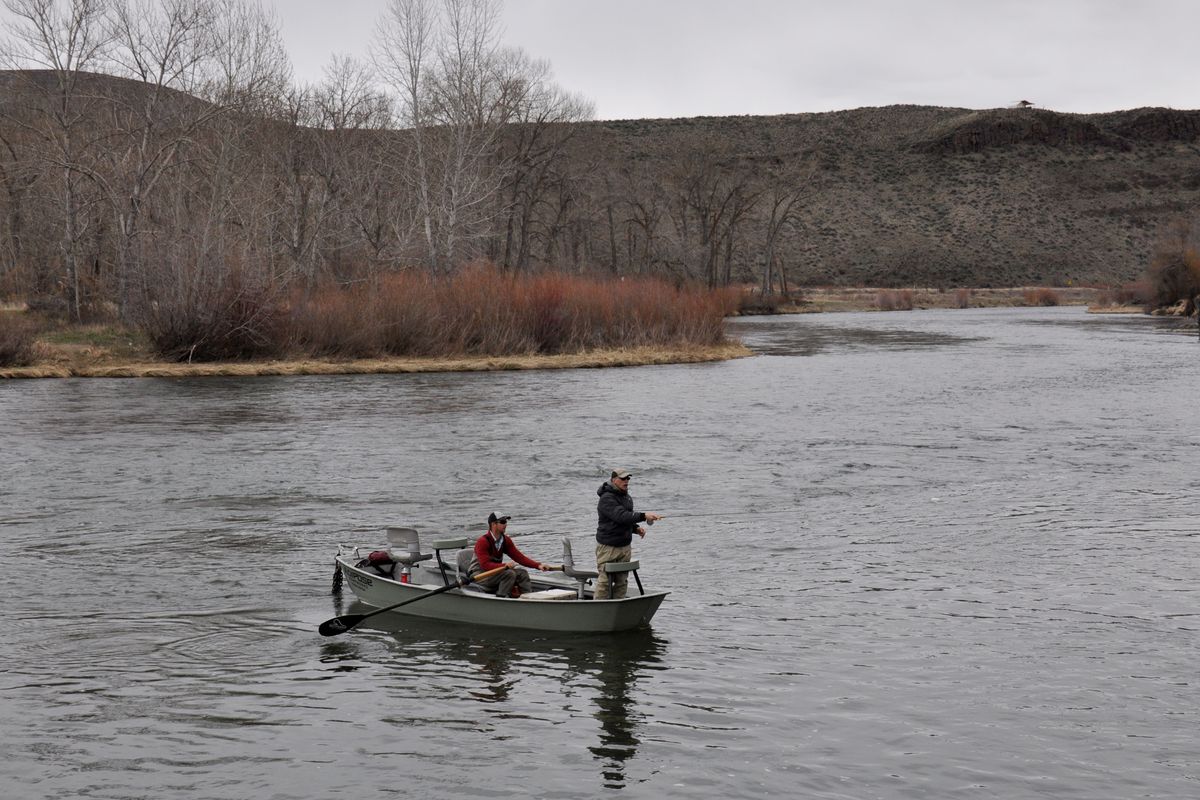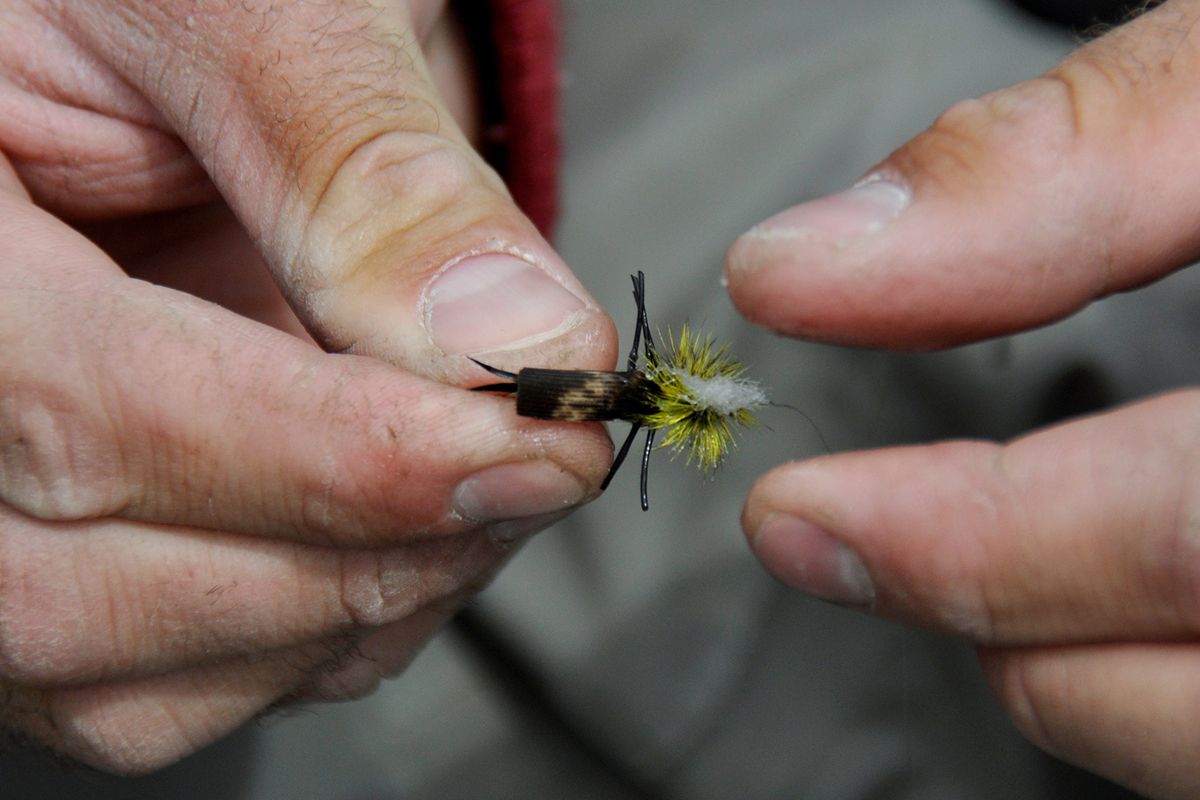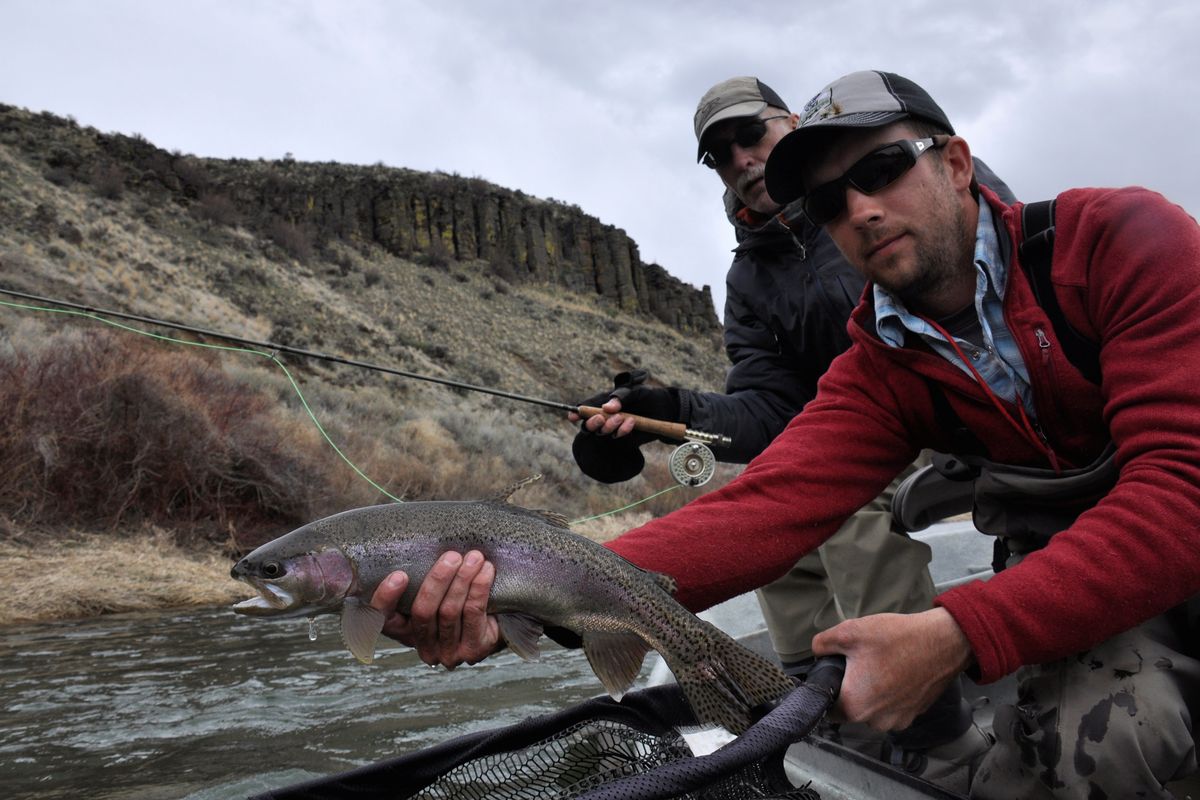Skwalameister pattern rocks the Yakima River
A Skwalameister dry-fly pattern is a highly visible imitation of the adult skwala stonefly. (Rich Landers)Buy a print of this photo
The skwala stonefly hatch on the Yakima River isn’t anything to shout about. No clouds of insect plastering pickup windshields. Even the fly shops don’t pump it up that much compared with outfitters who’ve hyped the Montana salmonfly hatch to legendary status.
But the Yakima’s hatch is certainly worth mentioning with at least a loud voice and a few arm pumps and high-fives.
Casting a skwala dry-fly pattern to a trout is like chucking a T-bone steak to a hungry cave man. Don’t expect much sipping. The strike is likely to be savage.
A trout inhaling a chironomid nymph 10 feet deep in a lake is no competition for such primal gratification.
Dave Moershel and I were lured to the Yakima last week by the prospects of hitting the hatch and the screaming deals fly fishing outfitters were offering to get anglers on the river in the cool weather of March and early April.
Wade-anglers have easy access to long stretches of the Yakima, especially the Canyon section south of Ellensburg. After exiting Interstate-90, an angler can drive along miles of the river on SR 821.
Choice stretches of the Yakima can be reached by hiking the foot bridge across the river from the Umtanum fishing access site and walking up or downstream.
But most of the good Canyon fishing stretches are along cliffs or brushy slopes that are out of reach to shore angling. Floating your own pontoon boat offers access to more water, but having a guide at the oars of a drift boat so you can focus on fishing from a moving boat is worth the investment on this river.
Moershel and I landed the services of Stefan Woodruff of Ellensburg Angler, a lucky catch.
He’s been fishing since the age of 6, and started exploring the Yakima from his West Side home as a kid with his fly-fishing-die-hard father.
“This was our destination,” he said.
He’s been guiding professionally for four years, yet at 23 he has the enthusiasm to deal with the cards he’s dealt and play the game like a pro.
“This isn’t bad at all,” he said, working his magic on our tangled lines after Moershel and I overlapped back casts. “You guys are doing a great job considering the wind.”
We started fishing in the morning using rubber-legged stonefly nymphs. Woodruff prefers a right-angle leader set up using heavy 30-pound saltwater mono from the fly line. This part of the leader tends to float. The strike indicator was attached at the end of the leader behind a loop.
To that we looped about 5 feet of 8-pound fluoro line, which sinks faster than mono. A spit shot was crimped above the knot attaching the tippet down to the fly.
Moershel hooked a big whitefish on this rig in the first 100 feet from the launch. Woodruff netted and released it faster than a teenager losing his parents at a school dance.
“Whitefish aren’t all that good for a trout guide’s reputation,” he said softly.
“Nice fish!” I yelled.
We caught rainbows and a few cutthroats regularly off the bottom – or at least when we had complete focus on the indicators. Woodruff had told us to set the hooks by raising our rods with our arms as though we were pulling the line off the water to make a cast. It worked.
But a tiny distraction, like the bald eagles nesting in the tree along the river or the weasel bouncing along the rocks, was all that was needed to be a fraction of a second late.
Woodruff still has a few things to learn, of course.
When we pulled out for a quick lunch of salad and grilled marinated chicken, Moershel and I set up the crimson folding chairs as Woodruff tended the grill.
“These chairs have WSU Cougars logos,” I said. “That’s risky, considering that most of your Yakima River clientele is probably from the West Side.”
“I thought they were a good deal – on sale at Fred Meyer,” he said. “But I had one Husky fan who refused to sit on them. He sat on the cooler.”
We’d been looking hard all morning for any sign of adult skwalas on the surface. Finally, at about 1 p.m., a splash in the river downstream was our cue to rig up with dry flies.
“Let’s go with the Skwalameister,” he said, pulling out olive flies with dark wings and a highly visible puff on top.
The first fish came quickly, dropping any hint of shyness as it slashed at my fly.
Only one fish in the next eight showed any hint of reservation or composure about attacking the surface.
It was not a fish a minute. We worked hard. At one point, to attract more attention, Woodruff tied on a two-dry rig with a big buoyant Chubby Chernobyl pattern trailed by a smaller low-riding Skwalameister.
Then the wind came up the canyon section in hat-snatching gusts.
Casting became more difficult as we worked to avoid hooking each other on the back casts and tried to punch the casts forward so the leader didn’t blow 10 feet upstream before hitting the water.
It wasn’t pretty, but we actually had the biggest flurry of fish to the boat near the end of the day in conditions that would have had me hanging up my rod if I’d have been floating the river on my own.
Woodruff says the Yakima’s dry fly action usually switches over to March Browns by mid-April.
But for now, his Skwalameister patterns rule.
And when my casting arm recovers, I’ll be back.





